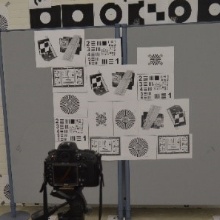Akintunde Hareef Akerele
On the role of image quality in photogrammetric processing – an empirical study
Duration of the Thesis: 6 months
Completion: June 2018
Supervisor: Dr.-Ing. Michael Cramer
Examiner: Prof. Dr.-Ing. Norbert Haala
Introduction
The examination of image quality is critical in photogrammetric processing, this research look through the impact it has on acquisition and analysis. The research tested D800E and D3200 camera with lens Nikon 35MM f/1.8g and AF-S DX NIikkor 18–55mm f/3.5–5.6g VR respectively. The image quality measure is both radiometric where the Modulation Transfer Function (MTF) at 50% contrast referred to as MTF 50 which is the measure of sharpness that is close to human perceived sharpness and the number of tie points in single stereo matching for image pair. Other measure taken from the single stereo matching is the Root Mean Square Error (RMSE). Some other measures were also taken like the Point Spread Function which is the function that is used to characterise imaging system resolving limit and also chromatic aberration. These two other parameters are not insightfully dealt with as much as MTF 50.
Methodology
The images are varied at ISOs (100, 200, 400, 800 and 1600) and F-stop (4, 5.6, 8 and 16 but 13 is included for the single stereo matching). Different cameras are used to capture the data to see how the camera quality impact results. with different quality, cost and use examined.
Results
The higher the value of MTF 50, the better is the quality of image when varied with at the sensor’s ISOs and F-numbers. The results are obtained by evaluating the images with QuickMTF a commercial version used to measure image quality and Software developed with Matlab by the IFP institute. The QuickMTF uses the slanted edge methodology while the IFP software uses Siemens star which are few of the methods used in the evaluation of MTF.
The result of the MTF 50 shows that the optimal setting of the setting of the sensor are usually at ISO 100 and F8 for the different evaluation from the different software which is shown by figure 2.0 where the maximum MTF 50 were obtained at that particular settings.
For the single stereo matching result on table 1.0, the result obtained also corresponding with that of the MTF 50. Most of the tie points and lower RMSE are obtained at ISO 100 and F8.
|
F-NUMBER |
4.5 |
5.6 |
8.0 |
13.0 |
16.0 |
||
|
I |
100 |
Number of Matched points |
2,016 |
2,168 |
2,368 |
2,014 |
1,280 |
|
Tie Point |
1,008 |
1,084 |
1,184 |
1,007 |
640 |
||
|
RMSE (PIX) |
5.53 |
6.10 |
5.48 |
6.02 |
6.17 |
||
|
400 |
Number of Matched points |
2,162 |
1,934 |
2,004 |
1,894 |
1,594 |
|
|
Tie Point |
1,081 |
967 |
1,002 |
947 |
797 |
||
|
RMSE (PIX) |
6.44 |
6.29 |
5.68 |
5.84 |
6.87 |
Table 1.0: Result of single stereo matching
Conclusion
Result of photogrammetric process has a direct link to the entire pipeline from image acquisition and associated quality, to the processing and the eventual outcome. Selection of sensors, settings and image acquisition methods can either make or mar the entire process. So the evaluation of the image quality like MTF 50 as a component of image radiometric property can give an insight to the quality of the photogrammetric result to expect.
Ansprechpartner

Michael Cramer
Dr.-Ing.Gruppenleiter Photogrammetrische Systeme




